E85 / FFV cars
- Flexible-fuel vehicles (FFV)
- Legislation, standards, and typical fuel properties
- Evaporative emissions, CO, and HC
- Aldehydes and ethanol
- Methane, 1,3-butadiene, benzene, and toluene
- Nitrogen oxides and ammonia
- Ozone forming potential
- Particles, PAH, and mutagenicity
- Intermediate blends (E30-E60)
- Summary
|
AMF work on E85/FFV cars:
|
High-oxygen-containing fuels, can be used in special flexible-fuel vehicles (FFV). Fuel containing ethanol up to 85% (E85) is used, for example, in Brazil, North America and in many European countries. In Brazil, FFVs are also designed for the use of hydrous E100 fuel. However, startability limit of neat ethanol is only approximately +12 °C, and startablitity problems may occur even at higher temperatures as demonstrated in the AMF Annex 44 (Fan & Donglian 2016) . In the US, so called P-Series fuel consisting of butane, pentanes, ethanol and the biomass-derived co-solvent methyltetrahydrofuran (MTHF) is permitted for use in FFVs. From the beginning, FFVs were designed for 85% methanol blend (M85), which is used today for example in China.
FFVs are basically spark-ignition gasoline cars with some modifications. For example, all materials in are compatible with ethanol, which is more aggressive towards materials than gasoline. Due to E85 fuel’s low heating value, fuel injectors in FFVs are designed for higher fuel flows than in conventional gasoline cars leading to higher volumetric fuel consumption. Feedback control in FFVs adjusts fuel delivery and ignition timing. Ethanol’s higher octane rating would enable an increased compression ratio to achieve better energy efficiency. However, even modern FFVs still represent a compromise as compared to dedicated ethanol cars.
The ignition of ethanol is poor. When using E85 fuel, excess fuel is injected during cold starts to achieve performance similar to gasoline cars. Therefore exhaust emissions tend to be high until the three-way catalyst (TWC) warms up (Lupescu 2009). Improved engine- and emissions-control technology is expected to reduce the exhaust emissions of FFVs in cold starts. Catalyzed hydrocarbon traps have been developed to store organic gases in cold starts until they can be removed when the TWC warms up (Lupescu 2009). Also intake port heating to reduce non-methane organic gas emissions has been studied (Chiba et al. 2010) and heated fuel injectors (Kabasin et al. 2009). All in all, the development of FFV cars is continuing in many areas.
Volumetric fuel consumption is higher for E85 fuel than for gasoline. The manufacturer’s figures for one FFV car equates to 33% higher volumetric fuel consumption for E85 than for gasoline, even though energy consumption as MJ/km is lower for E85 than for gasoline: 6.7 l (220 MJ) vs 8.9 l (205 MJ) per 100 km.
In AMF Task 52 report, the thermal efficiency from ethanol blended fuels was investigated using single cylinder Ricardo Hydra research engine. Tested fuels were neat gasoline and ethanol blends E20, E30, E50 and E85. The obtained thermal efficiency from ethanol blended fuels were in range of 30-34, which was a better efficiency than that for gasoline. Increasing ethanol content in fuels offered better antiknock property and allowed more advanced ignition timing.
Legislation, standards, and typical fuel properties
FFVs could in principle use many type of oxygenates, but E85 is the most commonly used today. Properties of E85 are close to ethanol properties. Ignition of ethanol as such is poor and therefore at least 15 vol-% of gasoline is needed in the E85 blend, and even more in the winter-quality fuel. The low energy content of ethanol leads to high volumetric fuel consumption. The octane numbers of E85 are higher than those of gasoline. E85 is not as sensitive towards water as low level ethanol/gasoline blends, however, phase separation may occur particularly with intermediate blends in the case of mixed refueling of E85 and gasoline and at low temperatures.
A number of issues must be taken into account when infrastructure and safety aspects are considered for E85 fuel. Special vehicles, materials and distribution systems are needed. Ethanol is flammable over a wide temperature range, which requires special safety measures. Guidance on materials, electrical conductivity, safety issues and other E85 aspects are presented in the E85 Handbook (2013) by the U.S. Department of Energy. These aspects are discussed also in Chapter ethanol properties.
In the U.S., E85 is specified by ASTM D5798 “Ethanol Fuel Blends for Flexible-Fuel Automotive Spark-Ignition Engines”. The properties of ethanol for E85 blending should meet ASTM D4806. Hydrocarbon blendstock may be unleaded gasoline, natural gasoline or other hydrocarbons, which meet the requirements given by ASTM D5798.
In Europe, E85 is specified by CEN 15293 “Automotive fuels – Ethanol (E85) automotive fuel – Requirements and test methods”. The EN 15293 defines four volatility classes. Ethanol for blending should comply with EN 15376.
In Canada, E85 is specified by CAN/CGSB-3.512 “Automotive ethanol fuel (E50-E85). &rdquo Four volatility classes are defined by this standard each with a specific 10% low-end design temperature for ethanol. The volatility class is based on the expected minimum temperature of use. Class I (summer) is greater than 5 °C and Class IV (winter) is less than -20 °C. The ethanol component shall meet the requirements of CAN/CGSB-3.516, Type 2 and the gasoline component shall meet the requirements of CAN/CGSB-3.5 or blendstock for oxygenate blending (BOB), that when blended with up to 10% by volume denatured fuel ethanol produces an oxygenated gasoline that complies with CAN/CGSB-3.511.
Examples of standards for the E85 fuel are shown in Table 1. At the time of this update, in Europe standard was from year 2018, while the year of last revision was 2017 in the US and 2013 in Canada.
Table 1. Examples of requirements for E85 fuel. Complete standards are available from respective organizations.
|
|
Standard 2018 |
Standard A 2017/B 2013 |
|
RON |
≥104 |
|
|
MON |
≥88 |
|
|
Density at 15 °C kg/m3 |
755 – 800 |
|
|
Oxidation stability, minutes |
≥360 |
|
|
Existent gum, mg/100 mL |
≤5 |
Washed ≤5 (A,B) Unwashed ≤20 (A) |
|
Copper strip corrosion (3 h at 50 °C) |
Class 1 |
No. 1 (B) |
|
Total acidity (as acetic acid), wt-% |
≤0.005 |
≤0.005 (A,B) |
|
pHe |
|
6.5 – 9.0 (A,B) |
|
Electrical conductivity, µS/cm |
≤1.5 |
≤5 (B) |
|
Vapor pressure |
a |
a |
|
Ethanol, vol-% |
b |
51 – 83 (A, Bb) |
|
Methanol, vol-% |
≤1.0 |
≤0.5 (A,B) |
|
Higher saturated mono-alcohols |
≤6.0 |
|
|
Ethers (C5+), vol-% |
≤11.0 |
|
|
Water content, wt-% |
≤0.4 |
≤1.0 (A,B) |
|
Inorganic chlorides, mg/kg |
≤1.2 |
≤1 (A,B) |
|
Copper |
≤0.10 mg/kg |
|
|
Phosphorus, mg/l |
≤0.15 |
≤1.3 (B) |
|
Sulfur content, mg/kg |
≤10.0 |
≤80 (A,B) |
|
Sulfate content, mg/kg |
≤2.6 |
≤4.0 (B) |
|
Appearance |
Clear and colorless |
clear (A,B) |
a Several classes. For example European 40 – 60 kPa, 60 – 90.0 kPa; ASTM 38 – 62 kPa, 48 – 65 kPa, 59 – 83 kPa, 66 – 103 kPa; Canadian, 38 – 62 kPa, 45 – 72 kPa, 62 – 86 kPa, 80 – 107 kPa.
b Several Classes, for example European 75 - 85 vol-%, 70 – 80 vol-% and 65 – 75 vol-%.
For example Canadian, 46 – 84%, 46 – 79%, 46 – 74%.
Evaporative emissions, CO, and HC
Fuel evaporative emissions are lower for E85 than for gasoline due to the E85 fuel’s low vapor pressure, potential reduction being approximately 30% (Yanowitz and McCormic 2009, Westerholm 2008, CRFA 2003). Nearly all FFVs have onboard vapor recovery system (E85 Handbook 2013, Martini et al. 2012). Haskew and Liberty (2006) observed lower permeation emissions for E85 fuel tested in the flexible-fuel vehicle system than for the low ethanol-content fuel. This is also seen in Figure 1.
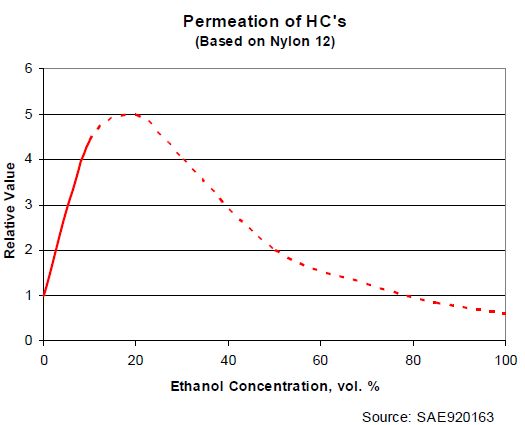
Figure 1. The effect of ethanol on permeation (Stahl et al. 1992, Kassel 2006).
In the AMF Task 44 (Fan & Donglian 2016), carbon monoxide (CO) reduced, while total hydrocarbons (HC) increased by switching to E85 from E10. In the earlier studies, CO and non-methane hydrocarbon emissions (NMHC) have often been lower, or not significantly changed, when comparing E85 with gasoline at normal test temperature (Yanowitz and McCormic 2009, Graham et al. 2008, West et al. 2007). However, at -7 °C higher CO and HC emissions have been observed for E85 than for gasoline (De Serves 2005, Westerholm et al. 2008, Aakko and Nylund 2003).
In the AMF Task 36, Sandström-Dahl et al. (2010) observed that the HC emission results for E85 depend on the calculation methodology used. The flame ionization detector (FID) detects all carbon-containing compounds, also oxygenates, and not only hydrocarbons. This is taken into account in the calculation methodology used in the US for non-methane hydrocarbons (NMHC = HCFID – 1.04 x CH4 – 0.66 x ROH) and non-methane organic gases (NMOG = ΣNMHC + ΣROH + ΣRHO). European emissions regulations does not recognize this behavior of FID. Furthermore, a higher exhaust gas density of 0.932 g/dm3 is used for for E85 (C1H2.74O0.385) than for gasoline (0.619 g/dm3 C1H1.85,) in Europe, whereas in the US calculation method density of 0.619 g/dm3 is used for both fuels. An example of the effect of calculation methods on the HC results is given in Table 2 for an FFV using the E85 fuel. The results obtained by the European calculation method for E85 are close to the NMOG results obtained by the US calculation method.
Table 2. HC emissions from FFV car using E85 fuel with different calculation methods (Aakko-Saksa et al. 2011).

In AMF Task 44 (Fan & Donglian 2016), higher ethanol, formaldehyde and acetaldehyde emissions were observed for E85 than for E10 during the first minutes after the cold-start of car, while emissions were very when the TWC catalyst was warm. The formaldehyde and acetaldehyde emissions were generally from 2 to 20 times higher with the use of E85 compared to E0 or E10 when tested at 22-23°C, and respective increases were even more pronounced at cold testing temperature. Elevated acetaldehyde and formaldehyde emissions for E85 have also been observed in the earlier studies, particularly at low sub-zero test temperatures (Yanowitz and McCormic 2009, Graham 2008 and West et al. 2007, Westerholm et al. 2008, Clairotte et al. 2013). Over the hot-start tests, acetaldehyde emissions have been low for E85 and E5 regardless of the test temperature (Task 44 Fan & Donglian 2016, De Serves 2005, West et al. 2007). Warm catalyst effectively reduces acetaldehyde emission, while formaldehyde emission may remain at relatively high level even with warmed-up catalyst (Aakko-Saksa et al. 2014).
Ethanol emissions are higher for E85 fuel than for gasoline, particularly at low test temperatures, but not necessarily in the hot-start test (Task 44 Fan & Donglian 2016, Yanowitz and McCormic 2009, Westerholm et al. 2008 and West et al. 2007). At cold temperatures, even 2.5% of the ethanol that is fed into the engine may release unburned (Laurikko et al. 2013). Ethanol may also transform to acetaldehyde in atmospheric reactions (Clairotte et al. 2013).
Chiba et al. (2010) observed that ethanol, formaldehyde, and acetaldehyde emissions represent a major part of NMOG emissions during engine cold starts with E85 (Figures 2 and 3). The latent heat of vaporization of ethanol is higher than that of gasoline, leading to poor cold-startability and high organic gas emissions during cold starts. NMOG emissions increased by about 50% in cold starts when E85 was compared with gasoline, and ethanol represented the highest share of NMOG. The evaporative characteristics of E85 may also lead to the condensation of unburnt alcohol in the combustion chamber (Chiba et al. 2010).
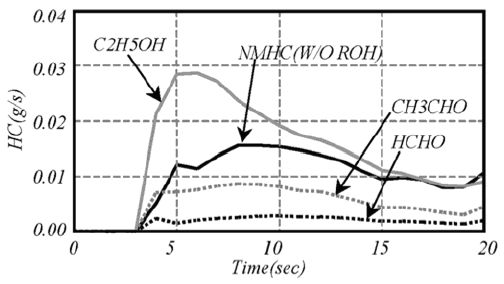
Figure 2. Ethanol, formaldehyde, acetaldehyde, and total hydrocarbons in cold starts with E85 fuel (Chiba et al. 2010).
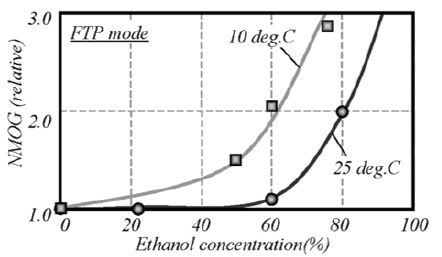
Figure 3. The effect of fuel ethanol content on NMOG emissions (Chiba et al. 2010).
Methane, 1,3-Butadiene, benzene, and toluene
Higher methane emissions have been observed for the E85 fuel than for gasoline at normal and at -7 °C, while 1,3-butadiene, benzene and toluene emissions are generally lower for E85 than for gasoline (Timonen et al. 2017, Clairotte et al. 2013, Yanowitz and McCormic 2009, Westerholm et al. 2008). In AMF Task 44, Fan & Donglian 2016 found that the dominating hydrocarbons for E85 were methane, ethene, xylenes and acetylene. Emissions of aromatic compounds (BTEX) were from 50% to 84% lower with use of E85 compared to E0/E10 at 22°C and at -7°C. Clairotte et al. (2013).observed that the exhaust gas contains more water when using E85 instead of E5, which may lead to decreased conversion of hydrocarbons in three-way catalyst.
The NOx emissions from FFVs running on E85 are generally lower than or at the same level as those from gasoline-fuelled cars (Yanowitz and McCormic 2009, Graham et al. 2008 and Westerholm et al. 2008). Yanowitz et al. (2013) noticed with nine in-use FFVs (Tier 1 and Tier 2) on average -25% reduction in the NOx emission when E76 was compared with E10. De Serves (2005) found lower NOx for E85 than for E5 both in the cold-start and hot-start tests. NOx consisted almost totally of NO indicating low NO2 emissions. In AMF Task 44, Fan & Donglian 2016 found relatively low NOx emissions for E85 and and only small differences between E85 and E10.
Ammonia emission from the TWC catalyst equipped cars have been observed at normal and cold test temperatures (AMF Task 44 Fan & Donglian 2016, Westerholm et al. 2008, Aakko-Saksa et al. 2014). Ammonia is formed in the TWC catalyst, and it is not primarily fuel-related emission (Mejia-Centeno et al. 2007). However, Clairotte et al. (2013) observed lower ammonia emission associated to E75–E85 than to E5, which could be due to leaner air-fuel ratio for E85 than for gasoline, or due to high water content of exhaust gas with E85.
Yanowitz and McCormick (2009) reviewed studies of the ozone-forming potential (OFP) for the E85 fuel. With Tier 1 vehicles, despite of lower ozone reactivity of the exhaust gases for E85 than for reformulated gasoline, the OFP for E85 was higher. Cold-start emissions seemed to dominate the result, and studies did not consider atmospheric chemistry, nor the effect of E85 fuel on NOx emissions. In the study by Graham et al. (2008), OFP was lower for E85 than for gasoline-fuelled FFV cars. Aakko-Saksa et al. (2011) observed higher OFP for E85 than for gasoline due to increased ethanol, ethene and acetaldehyde emissions, and also Clairotte et al. observed higher OFP for E75-E85 than for E5 with Euro 4 and Euro 5a cars at -7 °C.
Jacobson (2007) studied the effect of E85 on cancer and mortality in the US, Los Angeles basin. He concluded that the E85 fuel may increase ozone-related mortality, hospitalization, and asthma when compared to gasoline. The ratio between VOC and NOx is critical in estimating OFP. Ozone may increase for example in locations where the baseline ratio of reactive organic gases to NOx is below 8:1. Generally, both NOx and VOC emissions from vehicles are decreasing with tightening emission limits.
Millet et al. (2012) pointed out that the atmospheric impacts of increased fuel ethanol use will be minimal, because significant sources of atmospheric acetaldehyde already exist. In addition, the potency-weighted toxicity will be reduced with E85 use.
Particles, PAH, and mutagenicity
An FFV using E85 emits lower particulate matter (PM) emissions than gasoline-fuelled cars, which was pointed out for example in Task 54 (Rosenblatt et al. 2020), Task 35-2 (Rosenblatt et al. 2014) and AMF Task 44 (Fan & Donglian 2016), and also in other studies (Yanowitz and McCormic 2009, De Serves 2005). In Task 54, direct and indirect observations (tailpipe measurements and secondary formation in the smog chamber) suggest a favorable effect on PM emissions with alcohol fuel blends, particularly in the case of GDI vehicles. Minor effects of alcohol content (E21 and iBu12) on PM emissions were observed in the Unites States study on start-stop operation, although these were not consistent in all cases. For one Euro-5 GDI vehicle, ethanol blending gave substantial reductions in genotoxic potential of the eight carcinogenic PAH compounds, most pronounced in the hot WLTC with reductions of 77% and 84% for E10 and E85 respectively.
At cold test temperature of -7 °C, PM may be elevated for E85 probably due to its poor cold-start behavior (Westerholm et al. 2008). The PM emissions are generally low for the port fuel injected (PFI) cars at normal temperature (below 1 mg/km) (Westerholm et al. 2008). In AMF Task 44, Fan & Donglian (2016) observed that the direct-injection spark-ignited (DISI) car using E85 achieved as low PM as the PFI gasoline car.
In AMF Task 44, Fan & Donglian 2016 studied also number of particles (PN) besides PM emission. Number of “wet” and “dry” particles were low for E85. The use of E85 decreased dry PN emissions rate by 78% to 90% compared to E0. A shift to a lower primary peak diameter (from 70-80nm to 34nm at 22°C) was observed due to the use of E85.
Under the AMF Task 35-2, Rosenblatt et al. (2014) investigated the particle size distributions and PN emission rates of DISI vehicles using E85 fuel and operated over different drive cycles and at different ambient temperatures The rate of PN emissions was reduced by 70-90% between E85 and E0, and the distribution peak occurred at a smaller particle size (Figure 4). Results were consistent between different laboratories indicating the potential of E85 to mitigate particle emissions from DISI engines under a variety of operating scenarios.
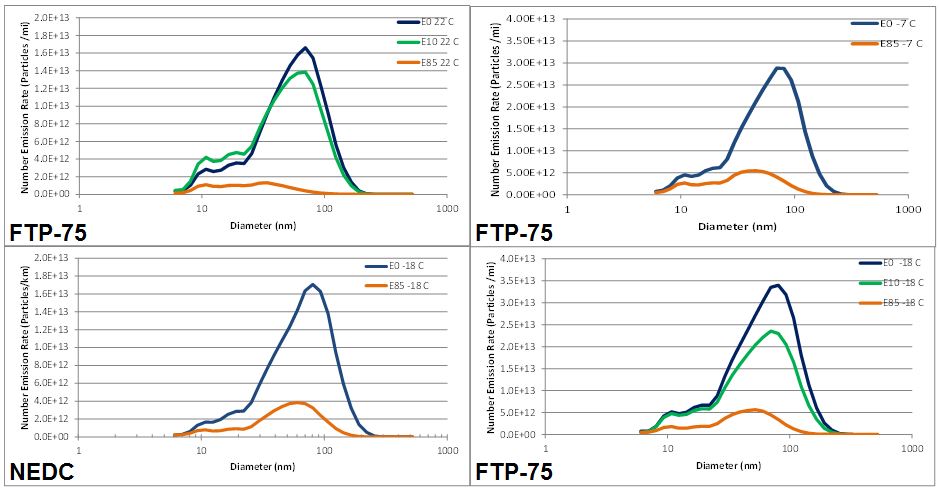
Figure 4. Average particle number size distributions for a FFV operated using E0, E10 and E85 fuels over the FTP-75 (EPA Federal Test Procedure) and NEDC (New European Driving Cycle) at different ambient temperatures. (Rosenblatt et al. 2014, AMF Task 35-2).
In the Task 35-2, Rosenblatt et al. (2014) draw the following key conclusions (Figures 4 and 5):
- The use of low- to mid- level alcohol blends (E10, E15, E20, iB16) with DISI engines/vehicles gave mixed results; with some studies noting decreases in particles and others showing increases. In contrast to the low level ethanol blends the E85 studies did yield consistent results indicating the potential to mitigate particulate emissions from DISI engines.
- E85 can reduce particle emissions from DISI engines under varying operating conditions and ambient temperatures.
- Number of particles was roughly an order of magnitude lower with E85 as compared to E10 and resulted in reductions in the range of 70 -90%.
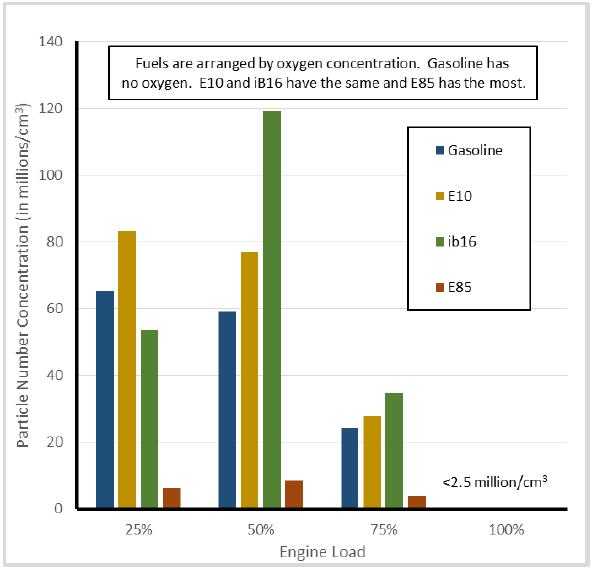
Figure 5. Particle number concentration for gasoline (no oxygen), ethanol and i-butanol (E10 and iB16, same oxygen content) and E85. (Rosenblatt et al. 2014, AMF Task 35-2).
Also Szybist et al. (2011) observed low PN emissions from DISI car when using E85 fuel, comparable to emissions from PFI. E85 enabled achieving the efficiency and power advantages of DI without generating the increase in PN emissions.
Timonen et al. (2017) studied E10, E85 and E100 in relation to primary emissions and subsequent secondary aerosol formation from a Euro 5 FFV. As the ethanol content of the fuel increased, the average primary PM decreased significantly. Similarly, a clear decrease in secondary aerosol formation potential was observed with a larger contribution of ethanol in the fuel. The secondary-to-primary PM ratios were 13.4 and 1.5 for E10 and E85, respectively. For all fuel blends, the formed secondary aerosol consisted mostly of organic compounds.
Particulate and semi volatile associated polyaromatic hydrocarbons (PAHs) together with cancer potency have been reported to be lower or at the same level for E85 fuel as for E5 at normal test temperature, while at -7 °C contradictory results have been obtained (Westerholm et al. 2008, Aakko-Saksa et al. 2014).
Intermediate-level ethanol fuels are common as a result of mixed re-fuelling of E10 and E85. In addition, blender pumps are available in the US. Haskew and Liberty (2011) studied emissions with E32 and E59 fuels in comparison to E10 and E85 over three driving cycles. NMHC emission decreased with increasing ethanol content over the US06 high speed/load test, whereas such trend was not seen over the cold start FTP test. CO and NOx did not indicate a trend with ethanol level. Fuel economy decreased with increasing ethanol content. The higher ethanol blends (E59 and E85) resulted in higher diurnal emission levels (different conclusion from CRC E-65-3), which was not in line with expectation of lower permeation of ethanol molecules for E85 than for E10. Acetaldehyde emission increased with increasing ethanol content with all three driving cycles. Formaldehyde emission increased with increasing ethanol content over two cycles, but not over the US06. The average Carter Reactivity of the exhaust decreased with increasing ethanol content of the fuels on the cold start FTP, but the results were not consistent for the US06 and Unified Cycle tests.
Yanowitz et al. (2013) determined the fuel economy and tailpipe emissions impact of operation on E40 on nine in-use FFVs (Tier 1 and Tier 2). Testing was conducted after a fuel change to study how the engine adapts the new ethanol concentration. The intermediate blends were not commonly available when older FFVs were built, and failure to rapidly adapt to a new fuel results in a non-optimal operation. Evidence was found of incomplete adaptation during the hot test immediately after refueling with E40, however, on average adaption to midrange blends was successful with average emissions falling between those of E10 and E76. Generally, the increase in emissions between E10, E40, and E76 was small compared to the measured differences between the different vehicle models.
In a study with low-oxygen fuels, E30 and E85 at -7 °C a reduction in NOx emission was observed with increasing fuel oxygen content for the Euro 4 emission level FFV (Aakko-Saksa et al. 2014). E30 and lower ethanol concentrations resulted in lower acetaldehyde, formaldehyde, ethanol, methane, ethene, and acetylene emissions when compared to E85. The emission level of 1,3-butadiene was very low in all cases. Acetaldehyde and ethanol emissions increased with increasing ethanol content of the fuel non-linearly: when changing from E30 to E85, acetaldehyde emission increased by 7.6 times and ethanol emission by 27 times. PM and PAH emissions were low and changes seemed not to be fuel-related with FFV. The indirect mutagenicity of PM extracts were lower for FFV than for the DISI car, but higher than for the MPFI car.
High-concentration ethanol fuels can be used in flexible-fuel vehicles (FFV). E85 is the most common fuel for FFVs today, although high concentration methanol blends are also used for example in China. Fuel injectors of FFVs are designed for higher fuel flows than those in conventional gasoline cars compensating the low heating value of E85. Energy efficiency of cars can be better when using E85 than when using gasoline, though volumetric fuel consumption is higher for E85. The energy efficiency of an FFV engine could be further improved by using an elevated compression ratio to utilize ethanol’s high octane rating, but engines still today represent a compromise as compared to dedicated ethanol cars. Direct injection technology provides improved fuel economy for spark-ignited cars, however, at cost of increased particle emissions. The use of E85 can mitigate this PM increase.
Compared with gasoline, E85 fuel reduces CO, NOx, benzene, toluene and 1,3-butadiene emissions, and also fuel evaporative emissions. In the opposite, acetaldehyde, ethanol, formaldehyde and methane emissions tend to be elevated for E85 when running with a cold engine. Particular strengths for the E85 fuel are low PM and PAH emissions, as well as low cancer potency compared with gasoline at normal test temperatures. The ozone-forming potential of E85 fuel may be higher than that of gasoline, although this issue is complex involving reactions of a number of compounds in relation to regionally varying atmospheric conditions. Many emission species from FFVs are high after cold-start, particularly at low ambient temperatures, as excess ethanol injection is needed before the car warms up. When the engine and catalyst are fully warmed-up, the differences in exhaust emissions between E85 and gasoline are small. Summary results of Graham (2008) are shown in Figure 5, and examples of other studies in Table 3.
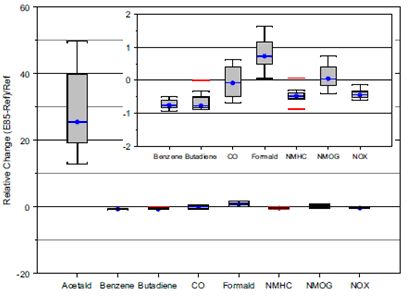
Figure 6. The effect of E85 on exhaust emissions (Graham 2008).
Table 3. Examples of changes in emissions when E85 is compared to gasoline (negative values = reduction in emissions, positive values = increase in emissions).
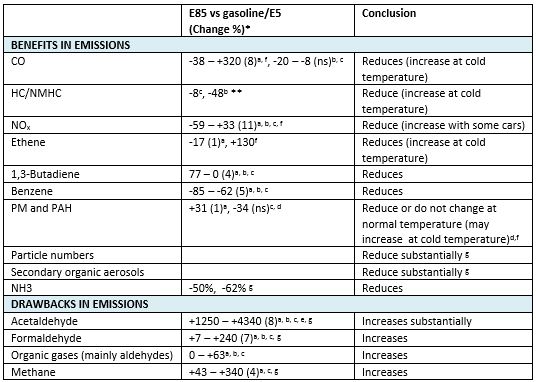
*) Number of studies reviewed in parentheses. ns = not significant
aJacobson 2007 bGraham 2008 cYanowitz and McCormic (2009) dWesterholm et al. (2008) eKarlsson 2008 fAakko-Saksa (2011), Clairotte et al. (2013) gTimonen et al. (2017)
References
Aakko, P. and Nylund, N.-O. (2003) Particle emissions at moderate and cold temperatures using different fuels. Warrendale: Society of Automotive Engineers. SAE Paper 2003-01-3285. Work within AMF Task 22, Final report.
Aakko-Saksa, P., Rantanen-Kolehmainen, L., Koponen, P., Engman, A. and Kihlman, J. (2011) Biogasoline options – Possibilities for achieving high bio-share and compatibility with conventional cars. SAE International Journal of Fuels and Lubricants, 4:298–317 (also SAE Technical Paper 2011 24-0111). Full technical report: http://www.vtt.fi/inf/pdf/workingpapers/2011/W187.pdf
Aakko-Saksa, P., Rantanen-Kolehmainen, L. and Skyttä, E. Ethanol, Isobutanol, and Biohydrocarbons as Gasoline Components in Relation to Gaseous Emissions and Particulate Matter. Environ. Sci. Technol. 2014, 48, 10489−10496.
Chiba, F., Ichinose, H., Morita, K., Yoshioka, M., Noguchi, Y. and Tsugagoshi, T. High Concentration Ethanol Effect on SI Engine Emissions (2010) SAE Technical Paper 2010-01-1268.
Clairotte, M., Adam, T. W., Zardini, A. A., Manfredi, U., Martini, G., Krasenbrink, A., Vicet, A., Tournie, E. and Astorga, C. Effects of low temperature on the cold start gaseous emissions from light duty vehicles fuelled by ethanol-blended gasoline. Appl. Energy 2013, 102, 44−54.
CRFA (2003) Canadian Renewable Fuels Association Website. http://www.greenfuels.org.
De Serves, C. (2005) Emissions from Flexible Fuel Vehicles with different ethanol blends. AVL MTC AB, Sweden. Report No AVL MTC 5509. Online http://www.senternovem.nl/ mmfiles/Emissions%20from%20flexible%20fuel%20vehicles_tcm24 280163.pdf.
E85 Handbook (2010) Handbook for Handling, Storing, and Dispensing E85. US Department of Energy. DOE/GO-102010-3073.
E85 Handbook (2013) Handbook for Handling, Storing, and Dispensing E85 and Other Ethanol-Gasoline Blends. US Department of Energy. DOE/GO-102013-3861.
Fan, Z. & Donglian, T. (Eds.), 2016. Research on Unregulated Pollutants from Alcohol-Fuelled Vehicles, Available at: http://www.iea-amf.org/app/webroot/files/file/Annex Reports/AMF_Annex_44.pdf. AMF Task 44.
Graham, L., Belisle, S. and Baas, C.-L. (2008) Emissions from light duty gasoline vehicles oper-ating on low blend ethanol gasoline and E85. Atmospheric Environment 42(2008) 4498–4516.
Haskew, H. and Liberty, T. (2006) Fuel permeation from automotive systems: E0, E6, E10, E20 and E85. Final report. CRC Project No. E-65-3.
Haskew, H. and Liberty, T. (2011) Exhaust and Evaporative Emissions Testing of Flexible-Fuel Vehicles, CRC Report No. E-80, August, 2011.
Jacobson, M. (2007) Effects of Ethanol (E85) versus Gasoline Vehicles on Cancer and Mortality in the United States. Environ. Sci. Technol. 2007, 41, 4150–4157.
Karlsson, H., Gåste, J. and Åsman, P. (2008) Regulated and non-regulated emissions from Euro 4 alternative fuel vehicles. Society of Automotive Engineers. Warrendale. Tech-nical Paper 2008-01-1770.
Kassel, R. (2006) An Environmental Perspective: EPA’s RFS Proposal. Presentation in the meet-ing of Mobile Sources Technical Review Subcommittee (MSTRS), October 4, 2006.
Laurikko, Nylund, N.-O. and Aakko-Saksa, P. High-Volume Ethanol Fuel Composition Optimized for Cold Driving Conditions. SAE Technical Paper 2013-01-2613.
Martini, G., Manfredi, U., Rocha, M. and Marotta, A. (2012) Review of the European Test Procedure for Evaporative Emissions: Main Issues and Proposed Solutions. European Commission, Joint Research Centre. Report Report EUR 25640 EN.
Mejia-Centeno, I., Martínez-HernaÌndez, A., Fuentes, G. Effect of low-sulfur fuels upon NH3 and N2O emission during operation of commercial three-way catalytic converters. Top. Catal. 2007, 42−43, 381−385.
Millet, D. B.; Apel, E.; Henze, D. K.; Hill, J.; Marshall, J. D.; Singh, H. B.; Tessum, C. W. Natural and Anthropogenic Ethanol Sources in North America and Potential Atmospheric Impacts of Ethanol Fuel Use. Environ. Sci. Technol. 2012, 46, 8484−8492.
Rosenblatt, D., Morgan, C., McConnell, S., and Nuottimäki, J. Particulate Measurements: Ethanol and Isobutanol in Direct Injection Spark Ignited Engines. AMF Task 35-2, Final report.
Rosenblatt et al. GDI Engines and Alcohol Fuels. AMF Task 54, Final report.
Sandström-Dahl, Charlotte, Lennart Erlandsson, Jan Gåsste, and Magnus Lindgren. 2010. “Measurement Methodologies for Hydrocarbons , Ethanol and Aldehyde Emissions from Ethanol Fuelled Vehicles.” Society of Automotive Engineers, no. SAE Paper 2010-01-1557: 1–20. AMF Task 36.
Stahl, W. and Stevens, R. (1992) Fuel-alcohol permeation rates of fluoroelastomers fluoroplastics, and other fuel resistant materials. SAE Technical Paper 920163. Referred to in Kassel (2006) An Environmental Perspective: EPA’s RFS Proposal.
Szybist, J. P., Youngquist, A. D., Barone, T. L., Storey, J. M., Moore, W. R. Foster, M. and Confer, K. Ethanol Blends and Engine Operating Strategy Effects on Light-Duty Spark-Ignition Engine Particle Emissions. Energy Fuels 2011, 25, 4977–4985.
Timonen, H., Karjalainen, P., Saukko, E., Saarikoski, S., Aakko-Saksa, P., Simonen, P. Murtonen, T., Dal Maso, M., Kuuluvainen, H., Bloss, M., Ahlberg, E., Svenningsson, B., Pagels, J.,Brune, W. H., Keskinen, J., Worsnop, D. R., Hillamo, R. and Rönkkö, T., 2017. Influence of fuel ethanol content on primary emissions and secondary aerosol formation potential for a modern flex-fuel gasoline vehicle. Atmospheric Chemistry and Physics, 17, pp.5311–5329. AMF Task 44.
Westerholm, R., Ahlvik, P. and Karlsson, H.L. (2008) An exhaust characterization study based on regulated and unregulated tailpipe and evaporative emissions from bi-fuel and flexi-fuel light-duty passenger cars fuelled by petrol (E5), bioethanol (E70, E85) and biogas tested at ambient temperatures of +22 °C and 7 °C. Final Report to the Swedish Road Administration, March 2008.
West, B., López, A., Theiss, T., Graves, R., Storey, J. and Lewis, S. (2007) Fuel economy and emissions of the ethanol-optimized Saab 9-5 biopower. SAE Technical Paper 2007-01-3994.
Yanowitz, J. and McCormic, R. (2009) Effect of E85 on tailpipe emissions from light-duty vehicles. J. Air & Waste Manage. Assoc. 59(2009)172–182.
Yanowitz, J., Knoll, K., Kemper, J., Luecke, J. and McCormick, R. L. (2013) Impact of adaptation on flex-fuel vehicle emissions when fueled with E40. Environ. Sci. Technol. 2013, 47, 2990−2997.


